Fetal electrocardiography
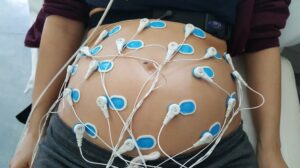
Congenital heart diseases represent a critical problem, with an incidence of about 1% among live births. The non-invasive fetal electrocardiogram (fECG) could significantly contribute to the diagnosis of congenital heart defects and fetal arrhythmias compared to current diagnostic tools, which allow for the analysis of cardiac activity only from a mechanical perspective. In fact, the use of fECG could provide the information related to fetal cardiac electrical activity, thus potentially guaranteeing a prompt therapeutic intervention in utero and the appropriate safety during labor. However, to date, the use of fECG for prenatal screening is still limited in the clinical setting, despite great advances in research.
Since 2008, the head of the MeDSP Lab has been collaborating with the Department of Pediatric Cardiology of Hospital G. Brotzu (Cagliari) to find solutions in this regard, focusing on advanced signal-processing algorithms to ensure good recovery of the fECG morphology and developing the first dataset combining non-invasive electrocardiographic measurements and fetal cardiac Doppler, now made available to all the researchers in the field on Physionet. In addition, the group is involved in the PRIN ICT4MOMS project, aiming to create a mobile system for remote monitoring of fetal and maternal well-being, based on wearable systems ensuring multimodal signal recording. The strong relationships with other research groups from all over the world allowed the organization of two scientific schools on the topic (2018 and 2021), thanks to the funding by Sardegna Ricerche.
Cardiac Electrophysiology
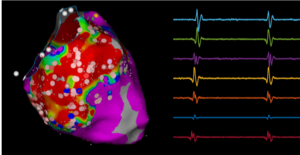
The study of cardiac electrophysiology not only supports the understanding of the arrhythmogenic substrates, but also allows to intervene and operate locally, identifying the areas from which the arrhythmias originate in order to silence them.
Electrophysiological studies are based on the acquisition of endocardial or epicardial depolarizations and repolarizations by means of appropriate multi-electrode catheters introduced in the cardiac chamber by minimally invasive procedures. These intracardiac recordings are called electrograms, and allow the electrophysiologist to reconstruct the pathways by which the excitable cardiac areas are sequentially activated. From the electrograms, it is possible to obtain important information and characteristics of these activations, which can be exploited and integrated in 3D maps of the cardiac chambers.
MeDSP collaborates with the staff of Graziana Viola, MD EP STAFF at Santissima Annunziata Hospital Sassari (Italy), and with Medical Concept Lab for the development of software tools and algorithms supporting the clinical staff in performing these procedures, with a primary focus on the post-ischemic ventricular tachycardias mapping and ablation procedures.
Telemedicine and telerehabilitation
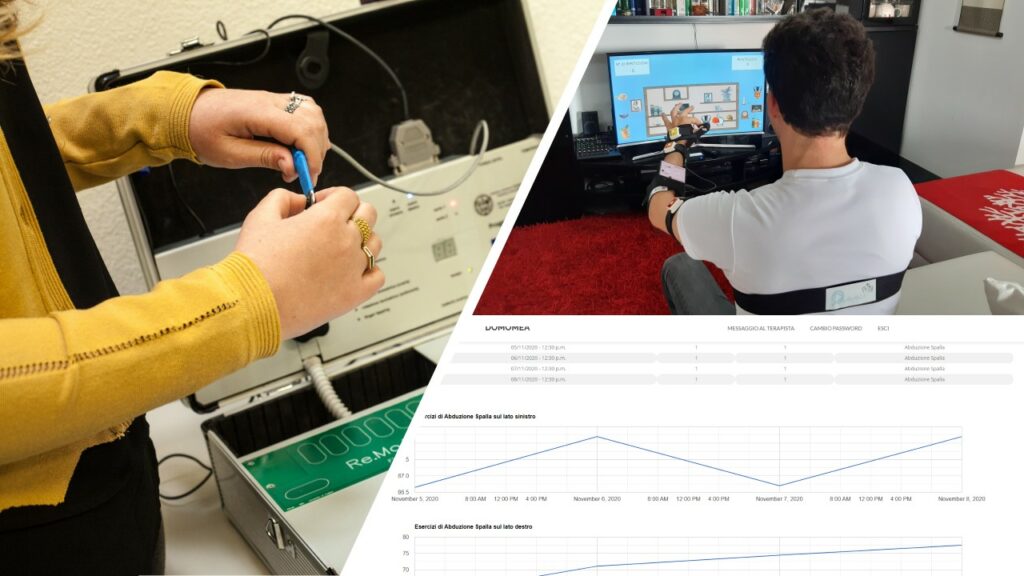
Telemedicine is a way to deliver health care services at a distance by using ICT to exchange patients’ data rather than moving patients or physicians for in-person meetings. The usefulness, effectiveness, and efficiency of telemedicine systems to provide medical services from remote is widely demonstrated in the scientific literature, and various solutions are entering the market. The onset of the COVID-19 pandemic stressed the need to be ready for providing health monitoring, visits, and home treatments from remote, by means of telemedicine solutions. The team has a long-standing experience in the field, with stand-alone solutions (Re.Mo.To. project for telerehabilitation of the hand in rheumatic patients), DVB-T based solutions for vital signs telemonitoring (Personal eCare and KeepInTouch Projects), tele-care solutions for the elderly (HEREiAM Project), Android-based telerehabilitation systems exploiting wearable sensors for stroke patients (DoMoMEA Project), etc.
Recently, the group developed a complete telerehabilitation system for stroke patients, DoMoMEA, thanks to a collaboration with the University of Sassari (Prof. Andrea Cereatti), which is obtaining high attention in the rehabilitation field.
Virtual Reality
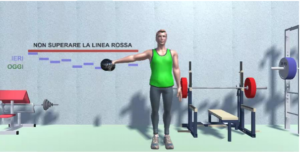
Virtual reality (VR) has now found wide application space in the clinical-health sector, at different levels. VR systems allow simulating particular scenarios or conditions, impossible to reproduce or difficult to control in the real world, in an interactive and safe virtual context in which the user is provided with specific multi-sensory stimuli. These features make them suitable to be used in rehabilitation (motor and cognitive) and in the treatment of patients affected by particular disorders or conditions.
The MeDSP Lab is active in various research projects that use VR systems, immersive and non-immersive, for clinical applications aimed at different categories of patients. Among its main activities is the development of systems for the rehabilitation of subjects affected by cerebral stroke, for balance training in patients with multiple sclerosis, and for the study of Heart Rate Variability in healthy subjects and neuropsychiatric conditions. The systems studied and developed so far exploit various kinds of sensors for the detection and measurement of physiological and biomechanical parameters of interest, eventually integrated into telemedicine devices. In this context, the exergaming approach is adopted, to increase the patient’s engagement in the therapy. Advanced studies are also working at the intersection between VR and perception.
Unobtrusive wearable sensing and beyond
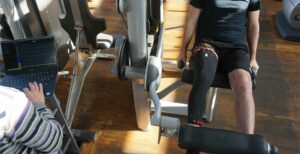 Unobtrusive monitoring of vital signs and physiological/biomechanical parameters is a cutting-edge research topic. The availability of multimodal sensing capabilities in smart garments allows the development of pervasive computing approaches in medicine, personalized healthcare, monitoring in sport and training, telerehabilitation, etc. On this topic, the MeDSP group has a long-standing collaboration with the DEALab, headed by prof. Annalisa Bonfiglio, and in particular with Dr. Andrea Spanu: the DEALab is active in the development of novel fabrication approaches with conductive polymers according to the different requirements, and the validation of these technologies is carried out by the MeDSP team with several scientific and technological partnerships. This activity has been the basis for several industrial projects and is currently the approach followed in the Search and Rescue project. MeDSP lab is also active in the design of custom wearable monitoring systems exploiting m-health approaches on Android platforms. From the wearable to the epidermal electronics there’s a sort of continuity, and this is the new frontier of the joint research in the field.
Unobtrusive monitoring of vital signs and physiological/biomechanical parameters is a cutting-edge research topic. The availability of multimodal sensing capabilities in smart garments allows the development of pervasive computing approaches in medicine, personalized healthcare, monitoring in sport and training, telerehabilitation, etc. On this topic, the MeDSP group has a long-standing collaboration with the DEALab, headed by prof. Annalisa Bonfiglio, and in particular with Dr. Andrea Spanu: the DEALab is active in the development of novel fabrication approaches with conductive polymers according to the different requirements, and the validation of these technologies is carried out by the MeDSP team with several scientific and technological partnerships. This activity has been the basis for several industrial projects and is currently the approach followed in the Search and Rescue project. MeDSP lab is also active in the design of custom wearable monitoring systems exploiting m-health approaches on Android platforms. From the wearable to the epidermal electronics there’s a sort of continuity, and this is the new frontier of the joint research in the field.
Perception studies and rehabilitation
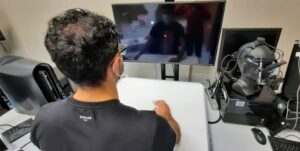 In daily activities, humans continually interact with the external world through perception and movements, which mutually influence each other harmoniously. We use an interdisciplinary approach to investigate this interplay, by combining behavioral experiments of psychophysics and sensorimotor interaction, neurophysiological studies and computational models. Following this perspective, sensory perturbations represent a well-documented tool in the context of adaptation to force fields or visuomotor rotations, as well as tests for assessing the capacity of perceptual discrimination and detection following a motor practice with a perceptual stimulus.
In daily activities, humans continually interact with the external world through perception and movements, which mutually influence each other harmoniously. We use an interdisciplinary approach to investigate this interplay, by combining behavioral experiments of psychophysics and sensorimotor interaction, neurophysiological studies and computational models. Following this perspective, sensory perturbations represent a well-documented tool in the context of adaptation to force fields or visuomotor rotations, as well as tests for assessing the capacity of perceptual discrimination and detection following a motor practice with a perceptual stimulus.
Since neural mappings from movement to the perceptual outcome and vice versa adapt continuously throughout life, also following the occurrence of sensory and motor impairments, we study neuromotor recovery based on repeated exercises and interactive stimuli, along with the design of patient-customized rehabilitation protocols, in order to gradually improve both perceptual and motor performance.
Eye tracking
![]()
More than 50% of the cerebral cortex of the human brain is involved with processing of visual inputs: the eyes constitute a very important window through which we actively interact with the outside world. Eye position is sometimes used as an implicit measure of what an observer is thinking about or where the observer is getting information. In addition, monitoring eye movements can help diagnose neurological diseases or dysfunctions involved in the control of the eye movements, such as glaucoma, Parkinson’s disease, essential tremor disorder, schizophrenia or autism spectrum disorder. The main tool for evaluating eye movements is the eye tracker, which monitors the eye fixation and measures changes in gaze direction. We investigate the functioning of the visual system and how eye movements depend upon physical characteristics of the stimuli or on context, expectancy or attention, for example by designing ad hoc gaze contingent displays.
Electrophysiology of taste
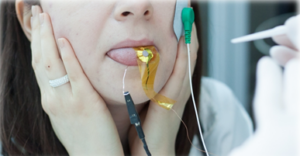
Electrogustography, or simply ETG, is based on the measurement of the potential evoked in the gustatory receptors inside the taste buds as a consequence of an external stimulus. The advantage of this technique is to perform the evaluation of the gustatory response objectively, which, conversely, is typically based on questionnaires or psychophysical approaches at present. It has already been demonstrated how the depolarization measure depends not only on the stimulus provided and its entity, but also on the individual genetic background.
MeDSP collaborates with the research group of Prof. Iole Tomassini Barbarossa and the DEALAB in order to develop an innovative device that allows recording the ETG signals, in order to objectively analyze the sensory response both in healthy subjects and those suffering from alterations in the sense of taste, and allow automatic assessment thanks to the adoption of machine learning algorithms.
New digital biomarkers for physiology studies
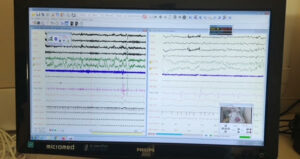
Digital biomarkers are markers obtained by the analysis of physiological signals that represent the new frontier of personalized medicine and a way to forecast the onset of chronic diseases. Among them, Heart Rate Variability (HRV) is a common measure able to provide information about the individual health status both at the cardiac and autonomic nervous system level. In fact, the heart rate is regulated by the autonomic nervous system, as the analysis of its variability is a reflection of sympathetic and parasympathetic activity. Several indices can be exploited for the analysis of HRV, both linear and non-linear, belonging to both time and frequency domains, whose values vary depending on the age or health condition.
MeDSP is involved in several studies in this area, based on the HRV and other physiological parameters analysis in healthy subjects and those affected by behavioral sleep disorders (in collaboration with the group headed by Prof. Monica Puligheddu), neuropsychiatric disorders (in collaboration with the group headed by Prof. Roberto Zuddas), and in the assessment of emotional states following the administration of multi-sensory stimuli in 3D virtual environments (in collaboration with Dr. Federica Donno).

